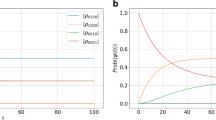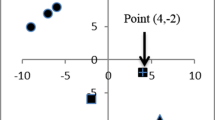Abstract
The interaction between two two-level atoms via photon exchange is simulated. The language of qubits is used with the aim of possible application of this model to the construction of quantum processors based on the interaction of several atoms with unit photons. The study involves a qubit form of the Jaynes-Cummings-Hubbard model with two-photon excitations and its polariton modification, in which any displacement of photons between cavities is associated with a photon absorbed or emitted by an atom. Relaxation is described by the Kossakowski-Lindblad equation for the density matrix of electron and photon states. The relaxation time is obtained as a function of the photon transition probability between atoms and of the amplitude of the photon interaction with an atom. Additionally, the degree of agreement between the density matrices in both models is calculated. An artifact of incomplete relaxation is described in the case of fuzzy qubit semantics, when the description of photons depends on their number.
Similar content being viewed by others
References
Zheng Shi-Biao, “Virtual-photon-induced quantum phase gates for two distant atoms trapped in separate cavities,” Appl. Phys. Lett. 94(15), 154101 (2009).
F. M. Ablayev, S. N. Andrianov, S. A. Moiseev, and A. V. Vasiliev, “Qunatum computer with atomic logical qubits encoded on macroscopic three-level systems in common quantum electrodynamic cavity,” URL: http://arxiv.org/pdf/1203/2201
Zheng Yicong and T. A. Brun, “Geometric manipulation of ensembles of atoms on atom Chip for quantum computation,” Phys. Rev. A 86(3), 032323 (2012).
E. Brion, K. Molmer, and M. Saffman, “Quantum computing with collective ensembles of multi-Level systems,” Phys. Rev. Lett. 99(26), 260501 (2007).
M. Bayer, T. Gutbrod, J. P. Reithmaier, A. Forchel, T. L. Reinecke, P. A. Knipp, A. A. Dremin, V. D. Kulakovskii, “Optical modes in photonic molecules,” Phys. Rev. Lett. 81(12), 2582–2585 (1998).
L. Fedichkin, A. Y. Fedorov, and V. Privman, “Measures of decoherence,” in Quantum Information and Computation (Proc. SPIE, No. 5105) (SPIE, Bellingham, 2003), pp. 243–254.
M. T. C. Wong and C. K. Law, “Two-polariton bound states in the Jaynes-Cummings-Hubbard,” Phys. Rev. A 83(5), 055802 (2011).
G. Lindblad, “On the generators of quantum dynamical semigroups,” Comm. Math. Phys. 48(2), 119 (1976).
V. Gorini, A. Kossakowski, and E. C. G. Sudarshan, “Completely positive dynamical semigroups of N-level systems,” J. Math. Phys. 17, 821 (1976).
E. T. Jaynes and F. W. Cummings, “Comparison of quantum and semiclassical radiation theories with application to the beam maser,” Proc. IEEE 51(1), 89 (1963).
A. D. Greentree, C. Tahan, J. H. Cole, and L. C. L. Hollenberg, “Quantum phase transitions of light,” Nat. Phys. 2(12), 856 (2006).
S. Schmidt, G. Blatter, and J. Keeling, “From the Jaynes-Cummings-Hubbard to the Dicke model,” J. Phys. B: At. Mol. Opt. Phys. 46(22), 224020 (2013).
C. Dugave, Cis-trans Isomerization in Biochemistry (Wiley-VCH, Weinheim, 2006), p. 56.
M. Braun, F. Gruber, M. Ruf, S. Kumar, E. Illenberger, H. Hotop, “IR photon enhanced dissociative electron attachment to SF6: Dependence on photon, vibrational, and electron energy,” J. Chem. Phys. 329(1–3), 148 (2006).
Author information
Authors and Affiliations
Corresponding author
Additional information
Original Russian Text © Yu.I. Ozhigov, N.A. Skovoroda, 2014, published in Vestnik Moskovskogo Universiteta. Vychislitel’naya Matematika i Kibernetika, 2014, No. 4, pp. 27–33.
About this article
Cite this article
Ozhigov, Y.I., Skovoroda, N.A. Simulation of a relaxation of electron shells of a pair of two-level atoms in qubit representation. MoscowUniv.Comput.Math.Cybern. 38, 164–170 (2014). https://doi.org/10.3103/S0278641914040062
Received:
Published:
Issue Date:
DOI: https://doi.org/10.3103/S0278641914040062




